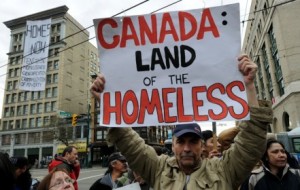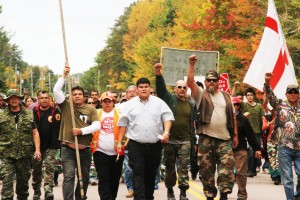
No homelessness on stolen Native land? How demands for wealth redistribution can rely on colonial domination

These days, a lot of thinking about how we organize our social movements is focused on the connections between different struggles. In the early 20th century, many movements for social justice and revolutionary transformation in North America took unity between struggles for granted. They imagined workers to be the leaders of a future world, and social class to be a shared identity that could unite everyone. The price of this unity was that other points of oppression, like race, gender or sexuality, were considered “secondary.” Since the radical 1960s movements challenged such narrow views of justice, the connections between different struggles has become a question rather than a confident assertion.
In the anti-displacement movement today, we are sometimes guilty of trying to answer these questions with rhetorical acknowledgement rather than the careful attention that they deserve. In Alliance Against Displacement and The Volcano we have defined our struggles by saying that our communities are squeezed between the dual forces of real estate development that causes displacement and resource extraction that causes dispossession. But what if the interests of those fighting real estate displacement actually contradict the anti-dispossession struggles of Indigenous peoples?
Losing our homes: defining displacement
Displacement is how we explain why more and more low-income people are being pushed out of their homes and communities. Displacement is an outcome of an economy focused on real estate speculation and development. The relationship between a real estate-based economy and low-income and working-class people in cities is fundamentally hostile. To continually grow within the spatial limits of cities, real estate industries must roll over low-income areas, destroying and redeveloping them. Belonging in such a city depends on your ability to buy into the housing market and to consume increasingly expensive goods.

Losing our lands: defining dispossession
But the real estate economy did not appear suddenly out of the air. Canada’s capitalist economy has relied on the theft of Indigenous land and the extraction of natural resources since it began. In British Columbia, almost all of the province’s land was literally stolen from First Nations because treaties were never signed. Even where there were treaties in BC or other provinces, they were usually misleading and unfair. While Indigenous people lost our lands, the government also tried to force us to give up our cultures and languages by stealing our children and putting them in residential schools. Even though the last residential school closed in 1996, the foster care system is still stealing our children and trying to assimilate us into white culture. While children are apprehended into foster care, youth and adults are apprehended into the prison system. Indigenous people today are fighting dispossession of our lands, our ways of life, and even our children.
Eliminating homelessness and poverty doesn’t eliminate dispossession
There are well-known techniques to reduce homelessness and poverty. If we redistributed wealth by taxing the wealthy and corporations, we could address displacement and build plenty of good, safe homes for everyone. We could even guarantee living wages, social assistance and education. Canadian governments have used some of these policies and they have worked in the past. But these policies of redistribution don’t address the fight against dispossession, or the return of Indigenous lands and resources to Indigenous sovereign control.
But what about low-income people? How can we suggest they have a stake in Indigenous dispossession? Historically, poor Brits and Europeans were lured to Canada by the promise of their own piece of land, a luxury that was unattainable in their home countries. Today, some people who want to claim their share of the Canadian settler promise blame those they feel are outside Canada for the poverty they are experiencing, whether they blame “foreign investment” or Indigenous peoples’ anti-pipelines campaigns. It is uncomfortable to admit, but sometimes demands for redistribution of wealth can seem the same as demands for a share of Indigenous land.
Connecting struggles through practice
It can be intimidating to discuss these tensions because it feels like they can’t be reconciled (pun intended), but we are posing these difficult questions because we are confident in the courage and tenacity of both working-class and Indigenous movements. It is not enough to rely on rhetoric like: our struggles are “united” or “all the same.” But if we acknowledge that our struggles sometimes contradict each other, we can begin to ask better questions. How can we as an anti-displacement movement refuse to collaborate with Indigenous dispossession? What can we do to further the national struggles of Indigenous peoples against dispossession? It’s not enough to say that our struggles are united – we have to find better ways of practicing what we preach and participating in both of the struggles against colonialism and capitalism.
